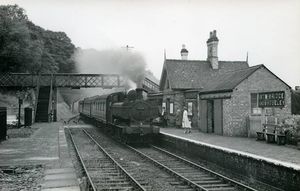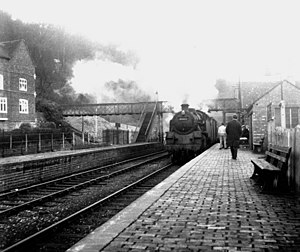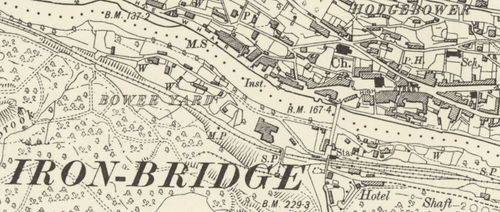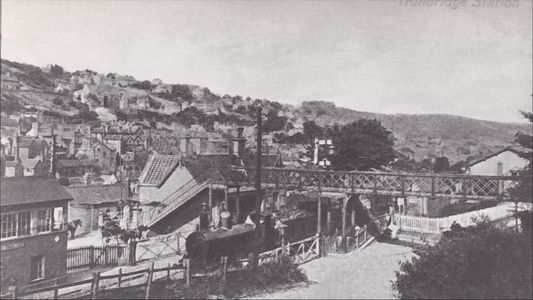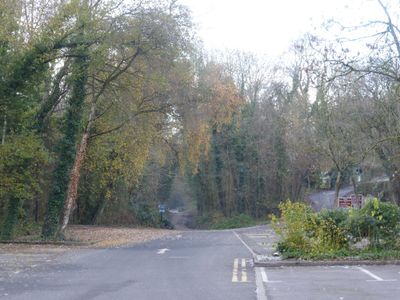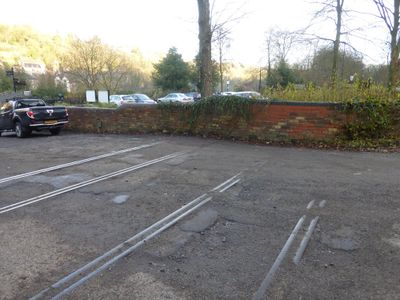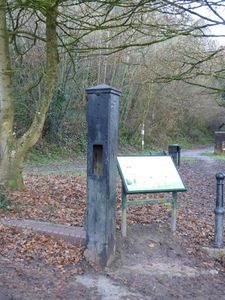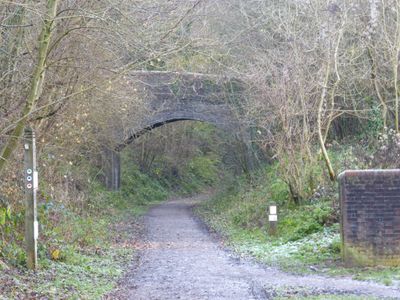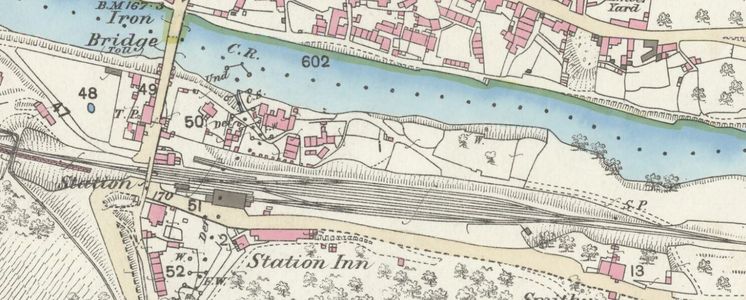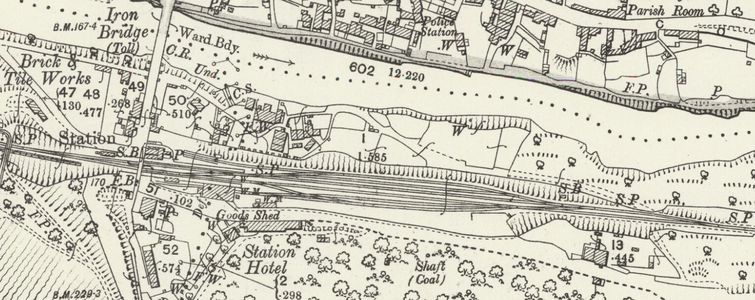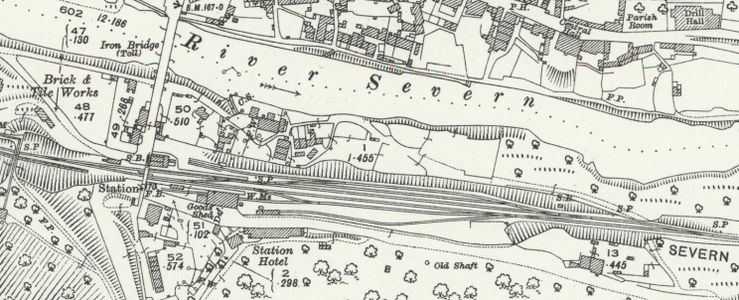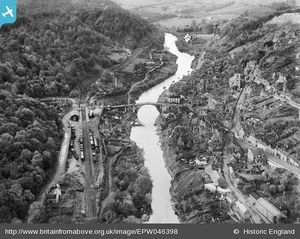
| Towards Hartlebury and Kidderminster | Towards Shrewsbury |
|---|---|
| Coalport (2 miles) via Jackfield Halt (from 1934) |
Buildwas (1½ miles) |
Ironbridge and Broseley, re-named "Iron Bridge and Broseley" in 1895 and often abbreviated to simply "Ironbridge", was a station situated 27 miles from Hartlebury and 13¾ miles from Shrewsbury.
Contents
Location
Ironbridge, like all the stations north of Victoria Bridge, was built on the west bank of the River Severn. The river runs almost due east-west at Ironbridge, and thus the station was situated on what was effectively the south bank, immediately south of Abraham Darby’s bridge after which the town was named. The Gorge is very narrow at this point, and much of the station lay on an embankment and plateau supported by a 15 metre high retaining wall.[1]
The station was probably used more by the people of Broseley, situated about ½ mile away on the same side of the river, and the site of tile and clay pipe making industries. The 1861 census showed the population of Broseley as 4,724, larger than Ironbridge (3,154). Ironbridge town itself is on the north bank, and crossing the bridge required payment of a toll until 1950, a fact that undoubtedly would have discouraged passengers from Ironbridge using the station.[1] Nearby Coalbrookdale, also on the north bank, had its own station on the Wellington-Much Wenlock line.
History
At opening on 1 February 1862, the station was the second of five crossing points south of Shrewsbury (Buildwas being the first and Bridgnorth the next). Like all the main stations, Ironbridge had a goods yard and goods shed, although the latter was built of wood rather than stone.[2]
The station had a footbridge, adjacent to the station building, connecting the two platforms. The station building was on the platform to the north of the line (nearer Ironbridge), while the goods shed was to the south of the line. A road level crossing was situated immediately west of the station which led to the Iron Bridge and also to Bower Yard.
On 9 November 1895 the name of the station was changed from 'Ironbridge and Broseley' to 'Iron Bridge and Broseley' on the recommendation of the General Manager.[3] The reason for this is unclear as the town is normally referred to as 'Ironbridge'; however the latter name for the station continued in use as may be seen in working timetables and on the running-in board in the Sellick photograph.
On 5 October 1898 the GWR's Traffic Committee approved the installation of a telephone between the station, Jackfield sidings and Maw and Co's Siding at a cost of £22, with Maw & Co being responsible for half the ongoing maintenance cost.[3]. Maw & Co made extensive use of the goods facilities at Ironbridge, and in 1905 their Board of Directors gave stationmaster Charles William Coldicott a retirement gift of £10 in recognition of "…his long connection with the Company, and his untiring courtesy…"[4]
The commercial postcard below shows a view of the station in the early 1900s, with a Shrewsbury-bound 2-4-0 standing on the station's level crossing. The 1894 signal box (see below) is on the left, and the wooden goods shed is on the right behind the footbridge.
Provision of an additional goods siding at Ironbridge at a cost of £90 was authorised in April 1908[3].
GWR staff records for 1922 show the station had a staff of 17, including those working at Jackfield sidings and Maw and Co's Siding.
In 1926 a truck weighbridge was installed.[5]
On 25 November 1956 the down line and platform were taken out of use, ending Ironbridge's use as a crossing point.[6]
The station closed to passenger traffic on 9 September 1963 when through traffic ended on the Severn Valley Line between Shrewsbury and Bewdley. However the goods yard remained open until 1 December 1963 when all goods services ended.[7]
The site today has become a pay and display car park for Ironbridge visitors. Few traces of the station remain, apart from sections of rail in the road crossing and a level crossing gatepost.
| Name | Born | From | To | Comments |
|---|---|---|---|---|
| Richard Young | 22 September 1839, Shipton, Oxfordshire | August 1863 | October 1866 | Joined West Midland Railway September 1853. Station Master at Stourport in September 1866. Died 26 July 1906 |
| Charles William Coldicott | 26 June 1844, Honeybourne, Gloucestershire | October 1871 | October 1905 | Joined West Midland Railway July 1859. |
| Robert George Eaton | 19 September 1861, Witney, Oxfordshire | January 1906 | 1913 | Retired 1913. Died 23 March 1936 |
| George William Chadwick | 1862, Marple, Cheshire | By 1917 | Joined Manchester Sheffield & Lincolnshire Railway July 1876. Died January 1934 |
Signalling
From opening in 1862, trains on the Severn Valley branch were worked using a single needle telegraph. Primitive signals, operated from the platform, controlled entry into the station, but departure into the section was authorised by verbal instruction only, given to the footplate crew after the appropriate telegraph messages had been exchanged.
Starting signals began to be introduced in the early 1870s; those at Bewdley and Ironbridge were authorised by the GWR Board on 30 August 1871 at a cost of £55.
The first 'proper' signal boxes on the branch were those at Bewdley which were authorised in 1877. All the other signal boxes dated from after 1880. At Ironbridge, a Great Western Type 5 brick signal box was commissioned in 1894 at a cost of around £1,545.[8] This was located adjacent to the level crossing on the west side, and can be seen in the postcard view of Ironbridge above. Electric staff working came into use between Hartlebury and Buildwas in the same year. Electric token working (of the type used on the present day SVR between Bridgnorth and Bewdley North) was not introduced until after the Second World War.[9]
The signal box interlocking frame, level crossing gates, point and signal connections were renewed in 1916 at an estimated cost of £1,050.[9].
The box was closed on 25 November 1956 when crossing of trains at Ironbridge ended.[6]. By 1962 the upper floor of the box had been removed and a small ground frame was installed outside the door.
Traffic statistics
| Passenger Traffic | Freight Traffic | |||||
|---|---|---|---|---|---|---|
| Year | Tickets issued | Parcels despatched | Revenue (£) | Tons received & despatched | Revenue (£) | Total revenue (£) |
| 1903 | 29,845 | 19,240 | 3,314 | 75,457 | 24,895 | 28,209 |
| 1913 | 24,247 | 19,681 | 2,719 | 65,253 | 18,948 | 21,667 |
| 1923 | 32,384 | 17,827 | 4,742 | 62,216 | 29,153 | 33,895 |
| 1933 | 19,195 | 21,354 | 3,276 | 40,780 | 18,322 | 21,596 |
| 1938 | 23,637 | 23,712 | 3,151 | 27,170 | 11,969 | 15,120 |
| 1942 | 33,466 | 16,395 | 5,083 | 27,794 | X | X |
| 1947 | 30,767 | 13,278 | 4,533 | 13,792 | X | X |
| 1952 | 16,392 | 18,953 | 4,656 | X | X | X |
X: Information not recorded
Historic maps of Ironbridge and Broseley station
See also
References
- ↑ 1.0 1.1 Vanns (1998/2013) p. 38.
- ↑ Vanns (1998/2013) p. 41.
- ↑ 3.0 3.1 3.2 Marshall (1989) p. 110.
- ↑ Vanns (1998) p. 100.
- ↑ Great Western Railway Magazine, January 1927
- ↑ 6.0 6.1 Mitchell & Smith (2007) 91
- ↑ Mitchell & Smith (2007) 93
- ↑ Marshall (1989) p. 131.
- ↑ 9.0 9.1 Marshall (1989) p. 134.
| ||||||||||||||||||||
